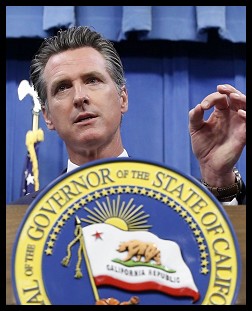 The state of California is embarking on a ground-breaking effort to manufacture and distribute a life-saving drug. The plan also deals a first major blow to private pharmaceutical companies that have long abused the nation's legal system for profit at the expense of the health of the citizenry.
The state of California is embarking on a ground-breaking effort to manufacture and distribute a life-saving drug. The plan also deals a first major blow to private pharmaceutical companies that have long abused the nation's legal system for profit at the expense of the health of the citizenry.
"On my first day in office I signed an Executive Order to put California on a path towards creating our own prescription drugs," Democratic Governor Gavin Newsom declared in a July 7 video posted to Twitter, referencing his inauguration promise in January of 2019. "And now it's happening".
Newsom's statement came in the wake of his approval of a Golden State Budget Proposal that will invest $50 million into development and $50 million more into a State-owned facility that will manufacture and distribute generic (aka biosimilar) insulin to Californians at slightly above cost.
If it succeeds, California, which has the world's 5th largest economy, will not only become the first State, but also the only government, other than Cuba, to embrace the socialized production of generic medications. (Although Cuba develops and manufactures its own generic medications and provides free "preventative medical care, diagnostic tests and medications for hospitalized patients", Pharmacy Times reported, "Cubans pay out-of-pocket for outpatient medications.")
California's progressive Democratic Governor pointed to the extraordinarily high cost of insulin as a form of "market failure" that justifies his embrace of socialized medications. His decision to allow the Golden State to produce its own generic insulin also highlights the immoral manipulation of the nation's patent laws by for-profit drug companies...
Market Failure
"Four giant monopolies," according to a pharmaceutical industry website in 2018, "account for about 72% of the global supply of insulin." That percentage would be even higher if you take the largest market, China, out of the equation. In that ostensibly communist, authoritarian nation, those four pharmaceutical monopolies compete with privately held Chinese pharmaceutical companies.
"Market failure" has been especially acute in the U.S. due to its pre-2022 failure to expand the Department of Veterans Affairs' single purchaser system to the Centers for Medicare and Medicaid Services (CMS).
(The newly enacted Inflation Reduction Act permits CMS to negotiate prescription drug prices and caps the monthly cost of insulin for Medicare recipients to $35. Senate Republicans blocked the effort to include all diabetes patients, including those with private insurance, within the $35 monthly cap.)
The cost to manufacture a vial of human insulin in 2018 ranged from $2.28 to $3.42. The cost to manufacture a vial of brand name analog insulin was between $3.69 and $6.16.
Nonetheless, in a September 2020 report [PDF], the U.S. Department of Health & Human Services (HHS) disclosed that "the manufacturer price for a standard unit of insulin in the U.S. in 2018 ($98.70) was more than ten times greater than the ($8.81) price in 32 OECD [Organisation for Economic Cooperation and Development] Countries." (Emphasis added).
There was a 3 1/2 year delay between Newsom's initial vow to socialize generic medication and the state legislature's budget approval to manufacture its own biosimilar insulin. That delay can be linked to the private pharmaceutical industry's manipulation and blatant abuse of intellectual property laws.
Patent System Abuse
As noted by the Congressional Research Service in a 2005 report [PDF], our "patent system is grounded in Art. 1, §8 of the U.S. Constitution", to wit: "Congress Shall Have the Power...To promote the Progress of Science and useful Arts, by securing for limited Times to Authors and Inventors the exclusive Right to their respective Writings and Discoveries." (Emphasis added)
The competing purpose between the exclusive rights created by patents and the imposition of time limits, Harvard Law Professor William Fisher explained, is to create a "balance" between the need to "stimulate inventions...and the tendency [that exclusive rights have] to curtail the widespread enjoyment of those creations."
Given that insulin was first discovered over 100 years ago, in 1921, and that the maximum period of exclusivity under U.S. patent law is 20-years from the date of application, the question naturally arises as to how the major, privately-owned pharmaceutical companies can hold insulin patent rights more than a century later?
The answer lies in the histories of insulin and the pharmaceutical industry's intellectual property law abuse.
Between its 1921 discovery and the 1980s, according to Healthline, "people with diabetes primarily received animal insulin from cows or pigs." In 1978, David Goeddel, a molecular biologist, engineered human insulin by growing the natural human insulin hormone inside E. Coli bacteria.
As documented by a 2017 observational study published by the National Institute of Health (NIH), the type of insulin available on the markets was linked to the life of existing patents. "In 2000", for example, "86.3% of insulin used in the UK was human and 10.7% [by a new, patent-protected and more expensive] analog insulin. By 2008, however, the use of human insulin had fallen to 23.2%, with analogs representing 76.1% of the total." This occurred, the NIH report noted, despite the fact that a World Health Organization (WHO) study failed to establish a "clinically significant difference" between human and analog insulins.
"The North American market," the study published by NIH observed, "is dominated by the small number of companies who are the sole suppliers of one or more of six insulin analogs, which are available exclusively as brand name products. There is no US or Canadian human, non-analog insulin."
The switch from human to newly patented analog insulin proved quite lucrative. The price of insulin "tripled from 2001 – 2012. It doubled again between 2012 - 2016", according to The American Journal of Medicine.
The industry was undeterred by the fact that it faced "imminent patent-expiration 'cliffs'" with respect to their first generation analogs, according to the NIH study. "The main insulin producers are continually filing for patents on analog insulins in their R&D pipelines."
Those pharmaceutical industry manipulations of patent law help to explain why the U.S. Food & Drug Administration (FDA) did not approve an interchangeable biosimilar insulin for the treatment of diabetes in humans until July 28, 2021. That FDA approval subsequently paved the way for California's decision to develop and produce its own generic insulin, finally, this year.
The WHO's inability to find a "clinically significant difference" between human and analog insulins raises a significant question as to whether patents should have been awarded to analog insulins to begin with, let alone repeatedly awarded for new generations of the same analog insulins. For a patent claim to be valid it must be "useful". How can a new analog insulin be considered "useful" if there's no clinically significant difference between the new analog insulin and either human insulin or the previous analogs for which exclusivity is about to expire?
It can't. And now California is finally leading the way in calling out the grotesque, immoral and deadly failures of the nation's pharmaceutical system.
 Ernest A. Canning is a retired attorney, author, and Vietnam Veteran (4th Infantry, Central Highlands 1968). He previously served as a Senior Advisor to Veterans For Bernie. Canning has been a member of the California state bar since 1977. In addition to a juris doctor, he has received both undergraduate and graduate degrees in political science. Follow him on twitter: @cann4ing
Ernest A. Canning is a retired attorney, author, and Vietnam Veteran (4th Infantry, Central Highlands 1968). He previously served as a Senior Advisor to Veterans For Bernie. Canning has been a member of the California state bar since 1977. In addition to a juris doctor, he has received both undergraduate and graduate degrees in political science. Follow him on twitter: @cann4ing


 Sunday 'Now Hoarding' Toons
Sunday 'Now Hoarding' Toons Mad World:
Mad World: 'Green News Report' 5/15/25
'Green News Report' 5/15/25
 Plane Corruption and the Future of the DOJ: 'BradCast' 5/14/25
Plane Corruption and the Future of the DOJ: 'BradCast' 5/14/25 'Deeply Evil': GOP Proposes Largest Medicaid Cuts in History: 'BradCast' 5/13/25
'Deeply Evil': GOP Proposes Largest Medicaid Cuts in History: 'BradCast' 5/13/25 'Green News Report' 5/13/25
'Green News Report' 5/13/25 And Then They Came for the Mayors...: 'BradCast' 5/12/25
And Then They Came for the Mayors...: 'BradCast' 5/12/25 Sunday 'New Guy, Old Guy' Toons
Sunday 'New Guy, Old Guy' Toons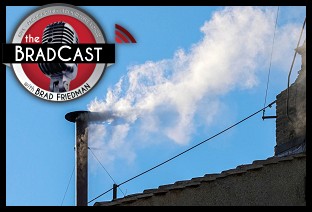 Blowing Smoke. At the Vatican and White House: 'BradCast' 5/8/25
Blowing Smoke. At the Vatican and White House: 'BradCast' 5/8/25 'Green News Report' 5/8/25
'Green News Report' 5/8/25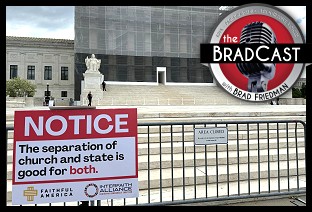 SCOTUS Weighs Public Funding of Religious Schools: 'BradCast' 5/7/25
SCOTUS Weighs Public Funding of Religious Schools: 'BradCast' 5/7/25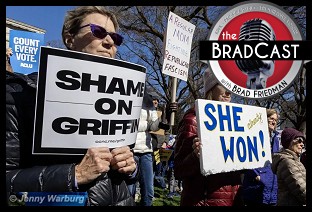 Trump Judge Blocks NC GOP Theft of 2024 Supreme Court Seat: 'BradCast' 5/6/25
Trump Judge Blocks NC GOP Theft of 2024 Supreme Court Seat: 'BradCast' 5/6/25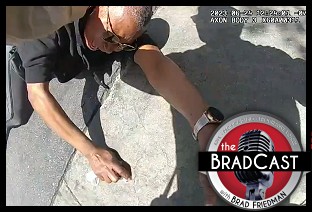 Prosecutors Quit After U.S Attny Strikes Deal With Felon Cop: 'BradCast' 5/5/25
Prosecutors Quit After U.S Attny Strikes Deal With Felon Cop: 'BradCast' 5/5/25 Trump Losing Streak Continues into SECOND Hundred Days: 'BradCast' 5/1/25
Trump Losing Streak Continues into SECOND Hundred Days: 'BradCast' 5/1/25 100 Daze (w/ Digby and Driftglass): 'BradCast' 4/30/25
100 Daze (w/ Digby and Driftglass): 'BradCast' 4/30/25 Campaign to 'Impeach Trump Again' Gains Fresh Momentum: 'BradCast' 4/29/25
Campaign to 'Impeach Trump Again' Gains Fresh Momentum: 'BradCast' 4/29/25 And Then They Came for the Judges...: 'BradCast' 4/28/25
And Then They Came for the Judges...: 'BradCast' 4/28/25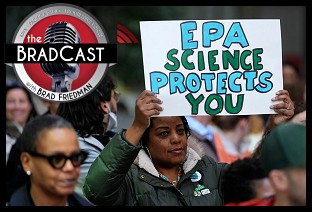 Trump EPA Guts Enviro Justice Office: 'BradCast' 4/24/25
Trump EPA Guts Enviro Justice Office: 'BradCast' 4/24/25
 VA GOP VOTER REG FRAUDSTER OFF HOOK
VA GOP VOTER REG FRAUDSTER OFF HOOK Criminal GOP Voter Registration Fraud Probe Expanding in VA
Criminal GOP Voter Registration Fraud Probe Expanding in VA DOJ PROBE SOUGHT AFTER VA ARREST
DOJ PROBE SOUGHT AFTER VA ARREST Arrest in VA: GOP Voter Reg Scandal Widens
Arrest in VA: GOP Voter Reg Scandal Widens ALL TOGETHER: ROVE, SPROUL, KOCHS, RNC
ALL TOGETHER: ROVE, SPROUL, KOCHS, RNC LATimes: RNC's 'Fired' Sproul Working for Repubs in 'as Many as 30 States'
LATimes: RNC's 'Fired' Sproul Working for Repubs in 'as Many as 30 States' 'Fired' Sproul Group 'Cloned', Still Working for Republicans in At Least 10 States
'Fired' Sproul Group 'Cloned', Still Working for Republicans in At Least 10 States FINALLY: FOX ON GOP REG FRAUD SCANDAL
FINALLY: FOX ON GOP REG FRAUD SCANDAL COLORADO FOLLOWS FLORIDA WITH GOP CRIMINAL INVESTIGATION
COLORADO FOLLOWS FLORIDA WITH GOP CRIMINAL INVESTIGATION CRIMINAL PROBE LAUNCHED INTO GOP VOTER REGISTRATION FRAUD SCANDAL IN FL
CRIMINAL PROBE LAUNCHED INTO GOP VOTER REGISTRATION FRAUD SCANDAL IN FL Brad Breaks PA Photo ID & GOP Registration Fraud Scandal News on Hartmann TV
Brad Breaks PA Photo ID & GOP Registration Fraud Scandal News on Hartmann TV  CAUGHT ON TAPE: COORDINATED NATIONWIDE GOP VOTER REG SCAM
CAUGHT ON TAPE: COORDINATED NATIONWIDE GOP VOTER REG SCAM CRIMINAL ELECTION FRAUD COMPLAINT FILED AGAINST GOP 'FRAUD' FIRM
CRIMINAL ELECTION FRAUD COMPLAINT FILED AGAINST GOP 'FRAUD' FIRM RICK SCOTT GETS ROLLED IN GOP REGISTRATION FRAUD SCANDAL
RICK SCOTT GETS ROLLED IN GOP REGISTRATION FRAUD SCANDAL VIDEO: Brad Breaks GOP Reg Fraud Scandal on Hartmann TV
VIDEO: Brad Breaks GOP Reg Fraud Scandal on Hartmann TV RNC FIRES NATIONAL VOTER REGISTRATION FIRM FOR FRAUD
RNC FIRES NATIONAL VOTER REGISTRATION FIRM FOR FRAUD EXCLUSIVE: Intvw w/ FL Official Who First Discovered GOP Reg Fraud
EXCLUSIVE: Intvw w/ FL Official Who First Discovered GOP Reg Fraud GOP REGISTRATION FRAUD FOUND IN FL
GOP REGISTRATION FRAUD FOUND IN FL

































